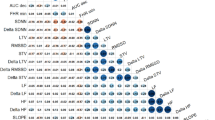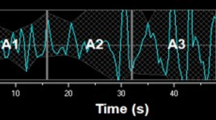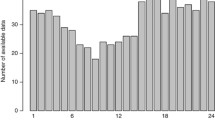Summary
The last 2 h of 342 intrapartum fetal heart-rate (FHR)-tracings (~ 41,000 CTG-minutes) were evaluated quantitatively with simple tools (compasses, caliper). All data were entered on punched cards (25/fetus) and further analysed using an IBM-system 370/135 (Fortran). The following parameters were recorded: the mean (estimated) base-line frequency per minute (bpm), the oscillationamplitude per minute (bpm), the oscillationfrequency (number of oscillations per minute) and several data of each deceleration and acceleration. The mean oscillationfrequency during the last 30 min amounted to 9.5±4.7 (N=4615 min without any decelerations/accelerations) in 253 fetuses with a pH (UA) above 7.200. The 5. percentile, the median and the 95. percentile were 2,9 and 18 events per minute respectively. It exists a highly significant association (Kolmogorov-Smirnov,α≪ 0.001) between the oscillationfrequency and the oscillationamplitude: reduction of the oscillationamplitude ist followed usually by reduction of the oscillationfrequency. The number of oscillations per minute is normally distributed (Kolmogorov-Smirnov) supposed that no medicamental or hypoxic stimuli are present and supposed that the oscillationamplitude is not too widley opened.
In acidotic fetuses the number of oscillations is diminished (approximately 3 events per minute) when compared with minutes of equal oscillationamplitudes. However this frequency reduction of oscillations becomes statistically significant only below an actual pH (UA) of 7.150 i.e. in fetuses with severe acidosis. Without computers alterations in oscillation patterns due to hypoxia are difficult to estimate in daily clinical routine. Therefore the overall clinical significance of this phaenomenon remains rather poor.
Zusammenfassung
Die beiden letzten Stunden von 342 intrapartalen, technisch einwandfreien Cardiotokogrammen (~ 41 000 CTG-Minuten) wurden manuell mit einfachen Hilfsmitteln (Stechzirkel, Schublehre) ausgewertet, die Daten auf Lochkarten übertragen (25/Fetus) und elektronisch auf einem IBM-System 370/135 weiterverarbeitet. Registriert wurden die mittlere Frequenz pro Minute, die Bandbreite (Oszillationsamplitude), Oszillationsfrequenz sowie wesentliche Daten aller Dezelerationen und Akzelerationen.
Die mittlere Oszillationsfrequenz der FHF von Feten mit einem pH über 7,200 (N=253) betrug in den letzten 30 min 9,5±4,7 bei 4615 auswertbaren dezelerationsfreien CTG-Minuten; die 5. Perzentile lag bei 2, der Median bei 9 und die 95. Perzentile bei 18 Oszillationen pro Minute. Es fand sich eine statistisch hochsignifikante und klinisch relevante Abhängigkeit der Oszillationsfrequenz von der Oszillationsamplitude in dem Sinne, daß Abnahme der Amplitude immer auch Rückgang der Frequenz bedeutet. Die Anzahl der Oszillationen ist normal verteilt, wenn hypoxische und medikamentöse Interferenzen eliminiert und die Oszillationsamplitude nicht zu weit gefaßt wird. Bei azidotischer Stoffwechsellage nimmt die Anzahl der Oszillationen bei konstant gehaltener Bandbreite um ca. 3 Ereignisse pro Minute ab. Dies läßt sich jedoch erst bei ausgeprägter Azidämie (pHNA<7,150) statistisch sichern (Kolmogorov-Smirnov). Der hypoxiebedingte Oszillationsfrequenzrückgang ist klinisch schwer exakt zu bestimmen; im Einzelfall mag das methodisch schwierige Auszählen der Makrofluktuation bei gegebener Bandbreite von Nutzen sein.
Similar content being viewed by others
Literatur
Hammacher, K.: Klinische Bedeutung der Zahl der Oszillationen pro Minute für die Bewertung des fetalen Zustandes sub partu. In: Perinatale Medizin, 8. Deutscher Kongreß, Berlin 1977. Stuttgart: Thieme (im Druck)
Richter, R., Hohl, M., Hammacher, K., Lüscher, K. P., Stucki, D.: The evaluation of the Oszillation frequency in intrapartum fetal monitoring. Obstet. Gynec. (in press)
Hammacher, K.: The clinical significance of cardiotokography. In: Perinatal medicine, 1st European Congress, Berlin. Huntingford, P. J., Hüter, K. A., Saling, E. (eds.). Stuttgart: Thieme 1969
Hammacher, K., Brun del Re, R., De Grandi, P., Richter, R.: Kardiotokographischer Nachweis einer fetalen Gefährdung mit einem CTG-Score. Gynäk. Rdsch.14, Suppl. 1, 61 (1974)
Hammacher, K., Hüter, K. A., Bokelmann, I., Werners, P. H.: Foetal heart frequency and perinatal condition of the foetus and newborn. Gynaekologia166, 349 (1968)
Hajeri, H., Schneider, L., Dauphin, F., Papiernik, E.: Silent fetal heart rate: Prognosis and patho-physiology in perinatal medicin, 4th European Congress, Prag 1974. Stembera, Z. K. et al. (eds.). Stuttgart: Thieme 1975
Hon, E. H.: An Atlas of fetal heart rate patterns. New Haven, Conn.: Harty Press 1968
Caldeyro-Barcia, R., Mendez-Bauer, C., Poseiro, J. J., Escacena, L. A., Posé, S. V., Bieniarz, J., Arnt, I., Gulin, F., Althabe, O.: Control of human fetal heart rate during labour. In: The heart and circulation in the newborn and infant. Cassels, D. E. (ed.). New York: Grune & Stratton 1966
Beard, R. W., Edington, P. T.: The results of attempts to monitor by continous FHR all patients admitted in labour. Perinatal medicine, 4th European Congress. Stembera, Z. K. et al. (eds.). Stuttgart: Thieme 1975
Fischer, W. M.: The heart rate pattern of the dying fetus. In: Perinatal medicine, 3rd European Congress. Bossart, H. et al. (eds.). Bern: Huber 1972
Fischer, W. M. et al. (eds.): Kardiotokographie, Lehrbuch und Atlas. Stuttgart: Thieme 1976
Roemer, V. M., Heinzl, S.: Mikro- und Makrofluktuation in der Cardiotokographie (in Vorbereitung)
Roemer, V. M., Elsenberger, T., Hinselmann, M., Bärtschi, R., Sänger, V., Hammacher, K., Favre, M.: Grundlagen der elektronischen Auswertung der fetalen Herzfrequenz. In: Perinatale Medizin, 5. Deutscher Kongreß, Berlin. Dudenhausen, J. W., Saling, E. (eds.). Stuttgart: Thieme 1973
Yen, S. Y., Forsythe, S., Hon, E. H.: Quantification of fetal heart beat-to-beat interval differences. Obstet. Gynec.41, 355 (1973)
Roemer, V. M., Ruppin, E.: Blutgasanalytische, elektro- und kardiotokographische Befunde bei einem Fall von schwerer intrauteriner Asphyxie. Geburtsh. u. Frauenheilk.31, 853 (1971)
Roemer, V. M., Ruppin, E., Bärtschi, R.: Direct foetal cardiography in management of high risk pregnancies. In: Proceeding of the international symposium on the treatment of foetal risks, Mai 1972. Baumgarten, K. v., Wesselius de-Casparis, A. (eds.). Amsterdam: Philips-Duphar 1973
Klöck, F. K., Austermann, R., Jung, H.: Bisherige Erfahrungen mit der direkten fetalen Elektrocardiographie. Geburtsh. u. Frauenheilk.30, 742 (1970)
Hon, E. H., Yeh, S. Y.: The electronic evaluation of fetal heart rate. X. The fetal arrhythmia index. Med. Res. Eng.8, 14 (1969)
Hellmann, L. M., Johnson, H. L., Tolles, W. E. et al.: Some factors affecting the fetal heart rate. Am. J. Obstet. Gynec.82, 1033 (1963)
Lippert, T., Roemer, V. M.: Direct treatment of the fetus during birth. JAMA225, 415 (1973)
Roemer, V. M., Leuenberger, F., Fluri, G., Willi, E., Ruppin, E., Neeser, H., Dieckmann, W., Stolz, E.: Azido-basische, elektrocardio- und kardiotokographische Befunde bei Schnittentbindungen. Perinatale Medizin, 4. Deutscher Kongreß. Saling, E., Dudenhausen, I. W. (Hrsg.). Stuttgart: Thieme 1972
Tournaire, M., Sturbois, G., Ripoche, A., Le Houezec, R., Breart, G., Chavinié, J., Sureau, C.: Evaluation of the fetal state by automatic analysis of the heart rate. 2. Deceleration areas and umbilical artery blood pH. I. Perinat. Med.4, 118 (1976)
De-Haan, I., Bemmel, J. H. von, Versteeg, B., Veth, A. F. L., Stolte, L. A. M., Janssens, I., Eskes, T. K. A. B.: Quantitative Auswertung der fetalen Herzfrequenzkurve. Perinatale Medizin, 3. Kongreß. Saling, E., Schulte, F. J. (Hrsg.). Stuttgart: Thieme 1972
Pardi, G., Benzi, G., Colombo, F.: Fetal heart rat Variability during labour. Contr. Gynec. Obstet.3, 22 (1977)
Saling, E.: Die O2-Sparschaltung des fetalen Kreislaufes. Geburtsh. u. Frauenheilk.26, 413 (1966)
Göser, R., Meierl, W., Fritschi, J., Conradt, A., Schlotter, C. M., Keller, A., Schindler, A. E.: Plasmahormonprofile bei Mutter und Kind. In: Verhandlung der deutschen Gesellschaft Gynäkologie und Geburtshilfe. Arch. Gyn.224, 125 (1977)
Göser, R., Conradt, A., Zubke, W., Keller, E., Schindler, A. E.: Endokrine Parameter des Geburts-stress. In: Perinatale Medizin, Vortrag Nr. 181. Stuttgart: Thieme (im Druck)
Laros, R. K., Wong, W. S., Heilbron, D. C., Parer, J. T., Schnider, S. M., Naylor, H., Butler, J.: A comparison of methods for quantitating fetal heart rate variability. Am. J. Obstet. Gynec.128, 381 (1977)
Berg, D., Kammacher, K., Schulz, I., Wernicke, K., Muschaweck, R., Gärtner, K., Bonath, K., Gremer, R.: Arbeitshypothese zur Genese der Herzfrequenzalteration — Beobachtungen am ausgetragenen Schaf-Feten. In: Perinatale Medizin, 3. Deutscher Kongreß. Saling, E., Schulte, F. J. (Hrsg.). Stuttgart: Thieme 1972
Vallbona, C., Carus, D., Spencer, W. A. et al.: Patterns of sinus arrhythmia in patients with lesions of the central nervous system. Am. J. Cardiol.16, 379 (1965)
Simons, D. G., Johnson, R. L.: Heart rate patterns observed in medicial monitoring. Aerospace Med.36, 504 (1965)
Klöck, F. K., Lamberti, G., Closs, H. P., Schwenzel, W., Austermann, R.: Kindliches Kardiogramm unmittelbar post partum unter Berücksichtigung des Kardiotokogrammes sub partu und der Säure-Basen-Parameter des Nabelschnurblutes. Perinatale Medizin, 3. Deutscher Kongreß. Saling, E., Schulte, F. J. (Hrsg.). Stuttgart: Thieme 1972
Richter, R., Hammacher, K., Hinselmann, M.: Die Bedeutung abnormaler Oszillationsfrequenzen im Kardiotokogramm. In: Perinatale Medizin, 7. Kongreß. Dudenhausen, J. W., Saling, E., Schmidt, E. (Hrsg.). Stuttgart: Thieme 1975
Dalton, K. J., Dawes, G. S., Patrick, J. E.: Diurnal, respiratory and other rhythmus of fetal heart rate im lambs. Am. J. Obstet. Gynec.127, 414 (1977)
Modanlou, H. D., Freeman, R. K., Braly, P., Rasmussen, S. B.: A simple method of fetal and neonatal heart rate beat-to-beat-variability quantitation: Preliminary report. Am. J. Obstet. Gynec.127, 861 (1977)
De-Haan, J., Van Bemmel, J. H., Versteeg, B. et al.: Quantitative Evaluation of fetal heart rate patterns. II. The significance of the fixed heart rate during pregnancy and labour. Eur. J. Obstet. Gynecol.1, 103 (1971)
De Haan, R., Patrick, J., Chess, G. F., Jaco, N. T.: Definition of sleep state in the newborn infant by heart rate analysis. Am. J. Obstet. Gynec.127, 753 (1977)
Grothe, W., Biesel, H., Rüttgers, H., Kubli, F.: Computer-aided intensive care of mother and fetus during delivery. In: Proceedings of Medcomp-Kongress, Berlin 1977 (in press)
Author information
Authors and Affiliations
Rights and permissions
About this article
Cite this article
Roemer, V.M., Heinzl, S. Zur Frage der Bedeutung der Oszillationsfrequenz in der Cardiotokographie. Arch. Gynak. 223, 299–313 (1977). https://doi.org/10.1007/BF00667369
Received:
Issue Date:
DOI: https://doi.org/10.1007/BF00667369




